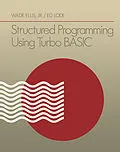Structured Programming Using Turbo BASIC explains programming methods using this language through mathematical or business examples and problems. The book approaches problem-solving using a top-down, structured programming method. This method consists of 1) breaking a problem into smaller, more manageable tasks, and 2) using the action block, the decision block, and the loop block-the three fundamental programming structures-to perform each task. The text describes the Turbo Basic environment on an IBM PC or compatible, the fundamental programming structures and concepts, the two data structures (arrays, files), graphics creation, as well as computer simulations. The book explains in detail variables, screen formatting, the decision block, the loop block, functions. The text also discusses parameter lists, and libraries The student learns to use the OPEN statement to associate a buffer with a file, or the CLOSE statement to end the file/buffer. The text explains the use of the Turbo BASIC random generator that produces unique sequences of random numbers. The book can be used in introductory lecture courses in business, computer science, or mathematics. It can be beneficial for students in an open-entry/open-exit computer laboratory courses or for self-study.
Inhalt
Preface
Acknowledgments
Introduction
The Development of the Discipline of Structured Programming
The Development of Turbo BASIC
Structured Programming in Turbo BASIC
How to Use This Book
Program Diskette for the Book
Chapter 1 Programming Environment
Objectives
Making a Work Disk
Booting up Turbo BASIC
Using Your Computer
1-1 Exploratory Activities
Making a Working Diskette
Booting up Turbo BASIC
Loading a Program
Saving a Program
Editing
Getting Help
Exiting Turbo BASIC
Printing
Erasing a Program on Diskette
1-2 Concepts and Methods
Summary of Commands
Chapter 2 Graphics and the Action Block
Objectives
Points on the Screen
The WINDOW and SCREEN Statements
Using the PSET, LINE, and CIRCLE Statements
The Action Block
Studying Example Programs
2-1 Exploratory Activities
2-2 Concepts and Methods
The Graphics Region
Using the PSET, LINE and CIRCLE Statements
The Action Block
The INPUT and PRINT Statements
Summary of Statements
2-3 Example Programs
Example 1 - Drawing a Wagon
Example 2 - Placing a Box
2-4 Exercises
Review Questions
Problems
Chapter 3 Top-Down Programming
Objectives
Top-Down Programming
Developing the Main Routine from the Program Skeleton
The Action Block
Subroutines
3-1 Exploratory Activities
3-2 Concepts and Methods
Top-Down Programming
Developing the Main Routine from the Program Skeleton
Subroutines and the Action Block
The Importance of Structure and Style
Summary of Statements
3-3 Example Programs
Example 1 - Stick Figure
Example 2 - Sailboat
3-4 Exercises
Review Questions
Problems
Chapter 4 Variables, Screen Formatting, and Arithmetic
Objectives
Using Variables in a Program
Getting Information Into Your Program
Getting Information Out of Your Program
Arithmetic Operations in Turbo BASIC
Using Parentheses in Turbo BASIC
Understanding E Notation
Studying Example Programs
4-1 Exploratory Activities
4-2 Concepts and Methods
Using Variables
Numeric Data Types
The PRINT Statement
Subroutines and Shared Variables
Arithmetic in Turbo BASIC
Parentheses
E Notation
The PRINT USING Statement (Optional)
Summary of Statements
4-3 Example Programs
Example 1 - Pricing
Example 2 - Temperature Conversion
4-4 Exercises
Review Questions
Problems
Chapter 5 The Decision Block
Objectives
Learning the IF/END IF Decision Block
Learning the Extended IF/END IF Decision Block
Learning the SELECT CASE Decision Block
Studying Example Programs
5-1 Exploratory Activities
5-2 Concepts and Methods
The Standard Decision Block
The SELECT CASE Decision Structure
The Comparison Operators
Compound Comparisons with Logical Operators
Summary of Statements
5-3 Example Programs
Example 1 - Vacation Car Rental
Example 2 - The Quadratic Formula
5-4 Exercises
Review Questions
Problems
Chapter 6 The Loop Block
Objectives
Repeating an Action Block
Counting Loops
The FOR NEXT Loop
The Standard Loop Block
Studying Example Programs
6-1 Exploratory Activities
6-2 Concepts and Methods
The Counting Loop
The FOR/NEXT Loop
The Standard Loop Block
Other DO/LOOP Constructs
Summary of Statements
6-3 Example Programs
Example 1 - Finding the Average of a Set of Numbers
Example 2 - Doubling Your Investment
Example 3 - Sales Commission
Example 4 - Graphing
6-4 Exercises
Review Questions
Problems
Chapter 7 Functions
Objectives
Built-In Functions Used with Strings
Built-In Numeric Functions
The RND Function
Defining Your Own Functions
Studying Example Programs
7-1 Exploratory Activities
7-2 Concepts and Methods
Built-In Functions
Numbers as Strings
The ASCII Character Set
Substrings of Strings
The RND Function
Defining Your Own Functions
Summary of Statements
7-3 Example Programs
Example 1 - Word Count
Example 2 - Retail Pricing
Example 3 - Volume Retail Pricing
Example 4 - Graphing Mathematical Functions
Example 5 - Graphing Piecewise-Defined Functions
7-4 Exercises
Review Questions
Problems
Chapter 8 Parameter Lists and Libraries
Objectives
Subroutines and Parameter Lists
Global and Local Variables
Using Subroutine Libraries
The Building Blocks of Structured Programming
8-1 Exploratory Activities
8-2 Concepts and Methods
Subroutines with Parameter Lists
Global and Local Variables
Developing Subroutine Libraries
The Building Blocks of Structured Programming
Summary of Statements
8-3 Example Programs
Example 1 - Lastname, First Initial
Example 2 - Inventory Reports
Example 3 - Regression Line Fit
8-4 Exercises
Review Questions
Problems
Chapter 9 Arrays
Objectives
Array Notation
Saving Space for Arrays
Using FOR/NEXT Loops with Arrays
Array Operations
Arrays in Parameter Lists
Studying Example Programs
9-1 Exploratory Activities
9-2 Concepts and Methods
Array Notation
Saving Space for Arrays
Using FOR/NEXT Loops with Arrays
Arrays in Parameter Lists
Summary of Statements
9-3 Example Programs
Example 1 - Sales Totals with String Arrays
Example 2 - Instructor's Grade Record
Example 3 - Systems of Linear Equations
Example 4 - Market Share
Example 5 - Inventory Database
9-4 Exercises…
